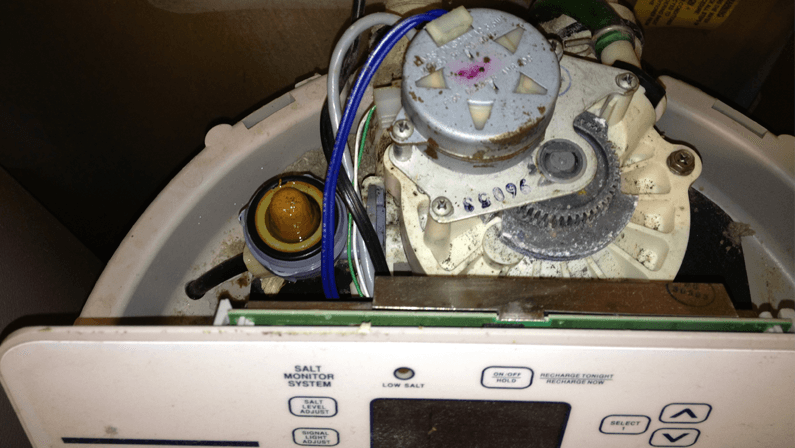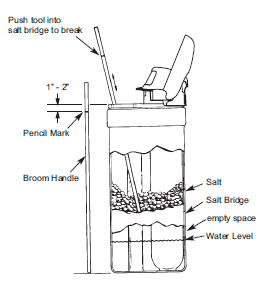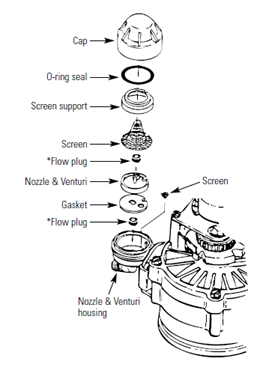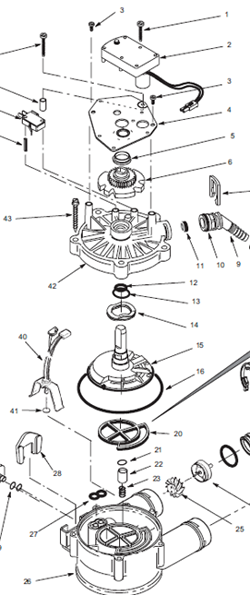From the Field: Common Service Problems with Big Box Softeners

“Big Box” stores like Walmart and Sears can be a 1 stop shop for just about everything you need: tires, lunch meat, underwear, and even water softeners.
Many of the water softener systems sold at these “Box Stores” have similar (in some cases identical) designs and components. As a result, they tend to have similar service requirements.
Being a “Full Service” water treatment dealer means we support every system we sell.
It also means that we repair, and carry parts for just about every other brand of water softener as well.
This article will look at the most frequent service problems our technicians encounter in the field with these “Big Box Water Softeners”.
Basic Water Softener Components and Functions
First, let’s cover the basic functions of a softener.
Water softeners use small plastic beads called resin to remove dissolved rock, aka “hard minerals” from water. To continue functioning, resin needs periodic cleaning (regeneration) with sodium or potassium. If the resin isn’t thoroughly cleaned, it will become damaged, and eventually the softening process will stop.
So let’s review the basic components that make the softening and regeneration process happen:
Controller – The brains of the unit that tells the water softener valve when and how to regenerate.
Valve – The engine and transmission that controls the different “cycles” or stages of the regeneration process.
Resin Tank – A fiberglass, steel, or plastic tank that contains the resin.
Resin –Plastic beads that are roughly the same size as a grain of sand. Ion exchange resin removes dissolved Calcium, Magnesium, and Iron to soften the water.
Brine Tank – The tank that holds the salt/potassium that is used to regenerate, or clean the resin beads inside the water softener.
Salt Bridges and 1 Piece Softeners

Ground water temperatures in the Twin Cities range from 48-51 degrees. Temperatures in mechanical rooms are usually between 70-75 degrees.
Much like a glass of cold water on a warm summer day, a resin tank full of cold water will begin to sweat.
“Big Box” softeners are built by placing the resin tank in the middle of the brine tank where dry salt is stored.
As moisture from the resin tank spreads into the dry salt, the salt begins to solidify and form a Salt Bridge. (picture from Kenmore Water Softener manual)
If a salt bridge is not broken up, the softener will be unable to regenerate with salt, and resin will become permanently damaged.
Salt bridge problems are almost completely eliminated by separating the resin tank and brine tank into (2) separate free standing units. This is one reason why virtually all professional grade water softeners use individual tanks.
Clogged Venturi Assemblies

During regeneration, there are two cleaning cycles that are absolutely critical:
- Water must be dispensed into the brine tank to dissolve salt and create a brine solution.
- The brine solution must be completely drawn up to regenerate and clean the resin.
This group of softeners uses a Venturi Assembly to complete both of these critical steps. (picture from GE Water Softener manual)
This parts layout shows the complex group of parts that includes several small screens, plugs, and gaskets. All of these are prone to clogging up with scale and iron and must be kept clean.
If the Venturi Assembly becomes plugged, the softener will no longer be able to put water into the brine tank, or draw it back out for regeneration. Once again, the resin will become permanently damaged.
Rotary Disc Damage

Last on our list is the “Rotary Disc” softener valve.
A rotary disc is just what it sounds like: a large plastic disc that rotates or spins inside the system during regeneration.
As it spins, the disc diverts water to different ports inside the valve body to operate each cleaning cycle.
If you remove about 13 screws, you’ll see this flat disc sandwiched in between the top and bottom of the valve body. (picture from Whirlpool Water Softener manual)
Water in suburbs like Chanhassen, Minnetonka, and Plymouth is 4-5x harder than the national average. Essentially, it’s like liquid sandpaper – very gritty, and very abrasive.
It’s easy to see how problems arise when you couple the large amount of surface area this design has with such extremely hard water.
These discs create so much friction that they begin to grind themselves away. Eventually, enough hard water scale builds up that these discs often freeze in place.
When this happens, you can experience any of the following:
- Water runs at the drain and never shuts off
- Water overflows the brine tank and floods the basement
- Water becomes salty-tasting from inadequate rinsing
- Softener stops using salt
Water softeners that use a piston-driven valve are far less prone to service. Well engineered designs have fewer moving parts, and both less friction and less travel in the moving parts.
Summary
Every water softener is a mechanical device, and in fairness to the systems mentioned in this article, they all may require service at some point.
We hope the tips in this article were helpful, and that you enjoyed learning more about these systems.
If your system doesn’t appear to be working, and you’re not sure what’s wrong, we offer a FREE SERVICE INSPECTION to help you determine if your system needs a repair. We can also be reached at (952) 479-4553 for more information.
Lastly, without too strong of a strong sales pitch, we carry water softeners with far more robust designs that eliminate 99% of the problems listed in this article 🙂
About Us
Premier Water is a local, family-owned water treatment company based in Chanhassen, MN. Since 1978, Premier Water has provided Award Winning Service for Residential and Commercial Water Softeners, Iron Filters, and Reverse Osmosis systems.

installed two weeks ago worked fine then did a gegen and now water is white and tastes like salt mod af-40k
Hey Dannie,
Sounds like the unit is not rinsing out the brine.
It seems a lot of people have problems with that unit. It has an odd design, kind of like a sideways Autotrol/GE.
We don’t service that model (although it’s sold as a “Premier Water Softener” by another manufacturer), but we may take that line on in the future.
Could be a kinked or clogged drain line
I have a whirlpool model whes20 water softener…it has quit. It shows on the led display…L50….these numbers will not change..you can hit every button…try to manual recharge…it will not change or respond…what now?
Sounds like you have a dead circuit board. I believe you can send in the faulty part, Whirlpool will assess, and then send a replacement part.
I have had a model WHES40 water softener for 2 to 3 years now and it has worked fine. All of a sudden, after regeneration, the salt brine tank fills up with water very slowly over a period of 2 or 3 days. I have cleaned the nozzle and venturi and the tank refill assembly and have double checked to make sure everything is back together properly. The water does not seem to be coming into the tank through the refill assembly. Any suggestions?
Is the softener regenerating ever day (it slowly fills over several days)?
Brine tanks usually overfill when water is added to the tank, but inadequate suction does not allow it to be drawn back out (usually the venturi).
Is the float working?
You could take apart the valve and check the rotary disc – those seem to become damaged after a few years in our market (20-25gpg hard water).
I have a whes40 and on display when i try to recharge it says recharge but never starts. Also says service fill in display flashing
Not sure who makes that unit. Was it sold at Costco and labeled a “Premier Water” softener? If so, we’ve had a few people have trouble with that unit.
when you push the bypass to the on position the Whirlpool softener will not stop running water out of the hose you have to put the softener on Bypass to get it to stop.
Thanks for posting!
Sounds like the rotary disc (possibly the valve body) has become scoured. You would need to rebuild the valve to fix this.
GE softener regenerates every two days. Salt is not going ( there is not a salt bridge )
Hey Bill,
It’s probably a plugged up injector or damaged rotary disc. Have you taken those apart and cleaned/inspected them?
Installed a Whirlpool today. Performed the setup instructions, including a regenerate cycle and flushing for 30 minutes with a downstream faucet. My water has now jumped up from 450 to over 500 ppm. Does it need to cycle more?
Thanks for posting!
That’s not totally out of line. Ion exchange softening is not an equal trade. A softener will add more sodium than the hardness it removes.
Also, keep in mind that your TDS meter must be calibrated and compensate for temperature. I’ve found cheap handheld meters can easily be off by 10-20%
Have appx 7 yr old whse30. It’s leaking from the out side of the bypass valve. Replaced o rings but still leaking. Not so bad if its in the bypass position. As soon as the water pressure builds you can see the bypass body moving out and starts to leak.any ideas? Thanks
Those bypass valves can be problematic! What is the line pressure. If its over 60psi, you may want to install a pressure regulator. The o-rings go bad alot, and the bypass and valve body seem to deform over time too (relatively thin/weak plastic).
Thanks for posting!
I Have the same problem with this plastic bypass,my question is can the O-rings be eliminated and PERMANENTLY bond the Bypass into the main housing with some type of glue?
You could….But you would have to replace the entire valve if the bypass still leaks (possibly a deformed bypass valve).
Thanks for posting!
i have a two year old GE water softener, model GXSH45V. The mode button doesn’t work anymore nor does the recharge button. Would suspect the control board as the failure? Have any idea on part number of that board perhaps?
That does sound like the board. You should be able to find the manual online if you lost yours. I would suspect there is a part # for the circuit board, or at least a number to call (may be a few more hoops to jump through…)
Thanks for posting!
My water softener in my landry room seems to be getting the carpet wet in an adjacent hallway. It seems the floor gets wet the day after the unit says it will “regenerate tonight”. Not sure if its pluming in the walls or if its the unit itself..
Have you checked to see if the floor drain backs up?
Thanks for posting!
The floor drain does not seem to be backing up. Plus the floor drain is about 6-8 feet away from the damp carpet/door jamb. But the plumbing for the softener is in the wall next to the damp area..(1-3 ft)..It dries out for a few days then seems to get wet again I believe around “regeneration” time
Thanks again for your input
Dan
I have what looks like a 1″ thick layer of potassium pellets on the bottom of the softener tank. This layer is like cement. What will dissolve it and more importantly, is it preventing the unit from working properly?
Sounds like the unit may not be drawing salt correctly, and the salt has sat too long. You could add 2 or 3 gallons of hot water and see if it dissolves. If not, you would want to bail out the water and scoop out the paste.
Thanks for posting!
I have a kenmore water softener. I have cleaned all the components but it doesn’t measure the water flow. The flow meter may meter for a gallon and then stop. Any ideas would be helpful. Thank you.
Probably a faulty meter turbine or meter cable – I’d replace those.
Thanks for posting!
I have a GE water softener. The model number is GXSF30V. It sits on a finished floor. It leaks water directly underneath it. I have checked for leaks and cannot find any. Could it just be condensation and how could I fix it?
Could be condensation – are you in a northern climate, or one with high humidity?
Could also be a crack/hole in the brine tank – could have been dragged or sat on a sharp object (nail).
You’d have to disconnect, tip over, and physically inspect the bottom.
Thanks for posting!
My water is mildly discolored after regeneration but clears up within a few minutes. Any ideas?
Sounds like you have iron/rust in the water. If the unit does not have a strong enough backwash, it will stir up the iron, but not flush it out.
Is this city or well water?
On Garage installed water softeners where the water heaters are in a separate area what is the typical or preferred method for drainage?
Seems most installs recommend drainage into a drain pipe in the floor.
Does PWT install french drains to accommodate this or is there a “fix” to get around it?
In Minnesota, water softeners are typically installed in the mechanical room – usually in a basement.
Drains must be air-gapped, and are usually run to either a floor drain or standpipe.
Thanks for posting!
Dealing with frustrated customers,,,you get what you pay for. Enjoyed your responses.big box 1 yr warranty!!
Thanks for posting!
In fairness, our experience is limited to the Minneapolis/St Paul area with these systems.
This post has drawn similar responses from around the country – so it seems they have a similar track record elsewhere 🙂
My softener has been working like a charm for a few years then boom total drop in water pressure / flow through the unit. Pressure is fine when I bypass so I know it’s the softener. Tried regen cycle, great flow and pressure as its regenerating but as soon as it finishes the cycle I’m back to no water. Tried this three or four times with no success. The system uses an autotrol valve. Tried disassembling and cleaning the head with no success. Any suggestions?
Resin is either fouled, or the system was overrun with sediment/debris. Probably need to replace resin and take the head apart and clean the system out. Hope that helps.
Thanks for posting!
I have a whirlpool water softener only a year old..has worked fine until recently..the only way it will recharge is if i hold down the button.
Could be a bad meter? Does it count gallons when you run water?
Thanks for posting!
I have a Whirlpool WHES33 water softener which had been working fine now the water is staying in the brine well half way up the tank. I have followed the instructions from Whirlpool and get the water drained back down but the next time I check it the water is back up again. Any suggestions?
This is most likely caused by a plugged venturi – better clean out the brine injector.
Thanks for posting!
We have a Whirlpool WHE40 softner. It is approximately 6 yrs old. All of a sudden we have reduced water pressure in the house. I have pushed the plastic bypass valve plunger on the unit but the water pressure does not change. When I bypass the unit outside of the house at a test hose bib the pressure is fine.
I wonder if the bypass is actually working? If it is working, there must be another obstruction somewhere in your home’s domestic water supply lines.
Thanks for posting!
I have a Whirlpool WHES20 and water is high, covering half the tank all day today.I tried to REGENERATE, couple times and moves only an inch up and then down. What could be wrong? Is it expensive to have a repair person look at this or buy a new one? When I regenerate manually, I can hear the cycles and sounds like normal operation.
Thank You!!
Sounds like a plugged venturri. Have you tried cleaning?
Thanks for posting!
We have a Kenmore Genius II Water Softener & recently the resin from the filtration system entered the water lines in our home & as a result we had to flush all the water lines & bypass the water softener. Would it be better to repair or replace the softener? Please advise
You could replace the beads and probably the distributor and upper basket. But the time…money…and headache are probably not worth it for that machine. I would replace if it was my house.
Thanks for posting!
I have a Kenmore water softener. I woke up one morning and notice the toilet plunger would not go down. I looked in the tank and what did I see but a whole lot of fine salt that looked like sand in the bottom of my toilet tank. I cleaned it out and behold the front bathroom toilet had the same problem. In addition, the faucet in both bathrooms were clogged with this fine sandy salt material. Even the shower heads were clogged. I had to take off the screens and shower heads and let the water run. I cleaned the water softener and put new salt. I am still experiencing some fine sandy material in the water lines. I changed from salt crystals to the regular salt which has bigger pellets. Any suggestions?
Is this “sand” yellow or orange? It sounds like resin – this could be a big problem. If it turns out to be sand, you need a good pre-filter to keep that out of the home.
Thanks for posting!
I have a GE Profile water softener PNSF35B00. Water continues to trickle from the drain line after recharge cycle is complete. Water was cut off for about a month while I was out of town. I have stepped through recharge cycle several times and water flow in each step seems proper. I assume the rotary valve has accumulated hardness deposits while the system was out of service. Is this something that can be corrected by removing the valve assembly?
Sounds like you are on the right track. You will most likely need to replace the disc and the seals around it (hopefully not the entire valve body).
Thanks for posting!
Have Kenmore model 625.383500 digital read out ceased working at six months old. Removed it was all rusted. Replaced it with new one, six months later ceased working unit rusted. My entire basement is dehumidified year round. What is up with this? Unit is $125.00 HELP
Thanks for posting!
This is very common with 1 piece systems (where the softener sits in the middle of the brine tank).
However, usually doesnt happen this fast. Such quick deterioration almost seems like this could be electrolysis.
Sorry I can’t help more.